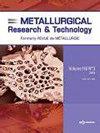Performance analysis of hot metal temperature prediction in a blast furnace and expert suggestion system proposal using neural, statistical and fuzzy models
IF 1.1
4区 材料科学
Q3 METALLURGY & METALLURGICAL ENGINEERING
引用次数: 1
Abstract
Blast Furnace (BF) production methodology is one of the most complex process of iron & steel plants as it is dependent on multi-variable process inputs and disturbances to be modelled properly. Due to expensive investment costs, it is critical to operate a BF by reducing operational expenses, increasing the performance of raw material and fuel consumptions to optimize overall furnace efficiency and stability, also to maximize the lifetime. The chemical compositions and temperature of hot metal are important indicators while evaluating the operation, therefore, if the future values of hot metal temperature can be predicted in advance instead of subsequent measuring, then the BF staff can take earlier counteractions on several operational parameters such as coke to ore ratio, distribution matrix, oxygen enrichment rate, blast moisture rate, permeability, flame temperature, cold blast temperature, cold blast flow and pulverized coal injection rate, etc. to control the furnace optimally. In this study, Artificial Neural Networks (ANN) model is proposed combined with NARX (Nonlinear autoregressive exogenous model) time series approach to track and predict furnace hot metal temperature by selecting the most suitable process inputs and past values of hot metal temperatures using the real data which is collected from the BF operated in Turkey during 2 months of operation. Various data mining techniques are applied due to requirements of charge cycling and operating speed of the furnace which secures novelty and effectiveness of this study comparing previous articles. Furthermore, a statistical tool, Autoregressive Integrated Moving Average (ARIMA) model, is also executed for comparison. ANN prediction results of 0.92, 8.59 and 0.41 are found very satisfactory comparing ARIMA (1,1,1) model outputs of 0.73, 97.4 and 9.32 for R2 (Coefficient of determination), RMSE (Root mean squared error) and MAPE (Mean absolute percentage error) respectively. Consequently, an expert suggestion system is proposed using fuzzy if-then rules with 5 × 5 probability matrix design using the last predicted HMT value and the average of the last 5 HMT values to decide furnace’s warming or cooling movements state in mid-term and maintain the operational actions interactively in advance.高炉铁水温度预测性能分析及应用神经、统计和模糊模型的专家建议系统方案
高炉(BF)生产方法是钢铁工厂最复杂的过程之一,因为它依赖于多变量过程输入和干扰,需要正确建模。由于昂贵的投资成本,通过降低运营费用,提高原料性能和燃料消耗来优化整体炉效率和稳定性,并最大限度地延长使用寿命来运营高炉至关重要。铁水的化学成分和温度是评价运行的重要指标,因此,如果可以提前预测铁水温度的未来值,而不是随后的测量,那么高炉工作人员就可以更早地对焦矿比、分布矩阵、富氧率、高炉含水率、渗透率、火焰温度、冷风温度等几个操作参数采取对策。对冷风流量、喷煤粉速度等进行优化控制。本研究利用土耳其某高炉2个月的实际运行数据,选择最合适的工艺输入和过去的铁水温度值,提出了人工神经网络(ANN)模型与非线性自回归外生模型(NARX)时间序列方法相结合的方法来跟踪和预测炉内铁水温度。由于炉料循环和炉速的要求,采用了多种数据挖掘技术,与以往的研究相比,具有新颖性和有效性。此外,统计工具,自回归综合移动平均(ARIMA)模型,也执行了比较。与ARIMA(1,1,1)模型的R2(决定系数)、RMSE(均方根误差)和MAPE(平均绝对百分比误差)的输出分别为0.73、97.4和9.32相比,人工神经网络的预测结果为0.92、8.59和0.41。在此基础上,提出了一种基于5 × 5概率矩阵设计的模糊if-then规则专家建议系统,利用最后一次预测的HMT值和最后5次HMT值的平均值来决定炉体中期的加温或冷却运动状态,并提前交互式地维持运行动作。
本文章由计算机程序翻译,如有差异,请以英文原文为准。
求助全文
约1分钟内获得全文
求助全文
来源期刊

Metallurgical Research & Technology
METALLURGY & METALLURGICAL ENGINEERING-
CiteScore
1.70
自引率
9.10%
发文量
65
审稿时长
4.4 months
期刊介绍:
Metallurgical Research and Technology (MRT) is a peer-reviewed bi-monthly journal publishing original high-quality research papers in areas ranging from process metallurgy to metal product properties and applications of ferrous and non-ferrous metals and alloys, including light-metals. It covers also the materials involved in the metal processing as ores, refractories and slags.
The journal is listed in the citation index Web of Science and has an Impact Factor.
It is highly concerned by the technological innovation as a support of the metallurgical industry at a time when it has to tackle severe challenges like energy, raw materials, sustainability, environment... Strengthening and enhancing the dialogue between science and industry is at the heart of the scope of MRT. This is why it welcomes manuscripts focusing on industrial practice, as well as basic metallurgical knowledge or review articles.
 求助内容:
求助内容: 应助结果提醒方式:
应助结果提醒方式:


